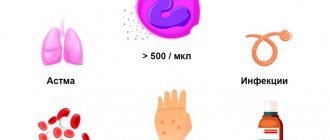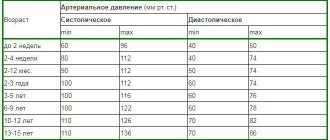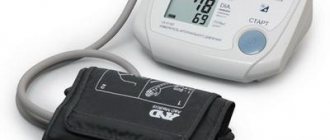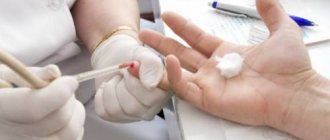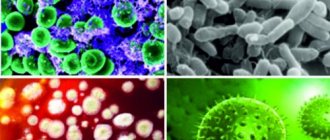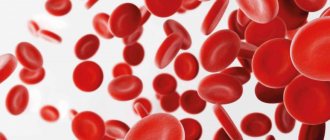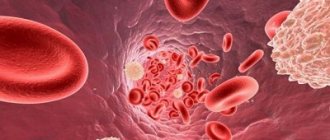Leukocytes, or white blood cells, are divided into three groups:
- Tissue macrophages or phagocytes. Macrophages are found inside organs and provide tissue protection. The mechanism of their work is that they capture the infectious agent and destroy it. These cells do not circulate throughout the body, so they cannot be detected in a blood test. But their predecessors, monocytes, are recorded in the bloodstream.
- Granular leukocytes. These cells contain granules or inclusions - vesicles with active substances, which are released from the cell in the event of invasion of infectious agents. Granular leukocytes take over the fight against bacteria. These cells include: neutrophils, basophils and eosinophils.
- Agranular leukocytes (agranulocytes). There are no inclusions in the structure of such leukocytes. These include lymphocytes. There are three types of agranular white blood cells: natural killer (NK) cells, T lymphocytes, and B lymphocytes. Each group of cells has its own characteristics and performs different functions.
Killer cells
Figure 1. Lymphocytes attack a cancer cell.
Image: animaxx3d / Depositphotos Natural killer (NK) cells are an important component of the immune system. The function of these cells is to destroy tumor cells and virus-infected cells of the body.
Tumor cells are formed in the human body every day, and it is the normal functioning of NK cells that is necessary to prevent tumors from developing. Natural killer cells get their name because they find and destroy damaged cells themselves.¹
T lymphocytes provide the body with a cellular immune response. This means that they form a chain of cells that act on the causative agent of the disease in order to destroy it. T-lymphocytes are different, they include:
- T-helpers. These cells find the infectious agent and present it to killer T cells. They are able to secrete special substances: cytokines and growth factors that activate the immune response.
T-helpers are not capable of destroying pathogens, but without them the functioning of cellular immunity is impossible. The human immunodeficiency virus (HIV) infects these cells. As a result of prolonged carriage of HIV without treatment, acquired immunodeficiency syndrome (AIDS) develops. AIDS is a deadly disease in which a person’s immune system does not work and the body becomes unable to resist the bacteria, viruses and fungi around it. Patients with AIDS experience severe, combined forms of infections that often do not respond to therapy.
At the same time, too strong activity of T-helper cells is also not the norm. In this case, they can react to normal cells of the body and lead to their destruction. Such conditions are called autoimmune diseases. The most common of them are autoimmune thyroiditis (Hashimoto's disease), type 1 diabetes mellitus, multiple sclerosis, rheumatoid arthritis, and systemic lupus erythematosus.
- Killer T cells. They are otherwise called T-cytotoxic lymphocytes. The function of killer T cells is to destroy cells infected with viruses and tumor cells. These lymphocytes differ from natural killer cells in that they react to specific antigens that T helper cells “indicate” to them.
- T-suppressors or T-regulators. Such cells act on T-helper and T-killer cells and reduce their activity in order to avoid an excessive immune response.
B lymphocytes are cells that provide the humoral immune response. This type of response involves antibodies. The body needs this immunity to neutralize toxins and pathogens that pathogenic bacteria produce. Antibodies are able to bind to pathogens or toxins, neutralize them and attract tissue macrophages to them. Antibodies are distributed throughout the body, they are found in the blood, intercellular fluid, and on mucous membranes.
B lymphocytes are of the following types:
- Actually B cells. These are lymphocytes that have not yet come into contact with antigens. After meeting a foreign agent, they are activated and transform into another type of B lymphocyte.
- Memory B cells. They have already encountered the antigen and “remembered” it. If the same pathogen is re-introduced, memory cells are able to quickly react to it. These are long-lived cells. Acquired immunity, which appears after an illness or vaccination, is based on the work of these lymphocytes.
- Plasma cells. Such lymphocytes do not live long and are formed in large numbers during the introduction of infectious agents. Their function is to produce antibodies.²
Figure 2. Types of lymphocytes. Image: mikrostoker/Depositphotos
Decreased lymphocytes
Patients ask themselves: what is the danger of a low lymphocyte count? The danger of this condition is due to the inhibition of the natural defenses of the human body. It can be a consequence of autoimmune pathologies, infection with the human immunodeficiency virus (HIV) or malignant lesions of the circulatory system.
It is important to note that during the acute stage of a bacterial or viral infection, the size of lymphocytes often decreases. The reason is the rapid death of protective cells when fighting infection, while new lymphocytes do not have time to be produced in sufficient quantities. In this case, in addition to antiviral drugs, the doctor prescribes immunostimulating drugs.
Read further: Lymphocytes are low - what does this mean and how to treat?
Blood test for lymphocytes
A blood test for lymphocytes is taken as part of an extended general blood test with a leukocyte formula. The formula prescribes the absolute number and relative content of all types of white blood cells. Blood can be donated from a finger or a vein.
In test forms you can find different designations for lymphocytes: LYMPH, LYM, LYM%. The unit of measurement is the number of cells per nanoliter of blood, as well as their percentage among all leukocytes.
Indications for analysis
A general blood test is the most accessible method for diagnosing various diseases and conditions. This analysis is indicated for undergoing a routine medical examination, before hospitalization, before and after surgery, for diagnosing diseases when first seeking medical help. Therefore, if the patient comes to the doctor in a timely manner, changes in the content of lymphocytes in the blood are detected quickly.
A doctor may suspect disturbances in the formation of lymphocytes and prescribe an analysis in the case of frequent and/or long-term infectious diseases. Sometimes these diseases can be difficult, difficult to treat and lead to complications.
Preparing for analysis
In order for a blood test to show an accurate result, proper preparation for it is necessary:
- Blood is taken for analysis on an empty stomach. The day before you should not eat fatty, spicy or sweet foods. It is better if the dinner is light and at least 8 hours pass before the analysis.
- Before the study, you need to get enough sleep and eliminate physical and emotional stress.
- You should avoid overload on the day before donating blood: do not exercise too much, do not go to the bathhouse or sauna, and maintain a drinking regime.
- It is necessary to refrain from smoking at least 2 hours before donating blood for analysis.
- If you are taking any medications, you must tell the medical staff when your blood is drawn.
- Norms of lymphocytes in the blood - tables with norms for women, men, children
- The normal number and percentage of lymphocytes differ depending on gender and age.
Table 1. Norm of lymphocytes in the blood of women and men.
| Absolute quantity | Percentage | |
| Among women | 1 - 3.4 x 10⁹/l | 17-38% |
| In men | 1 - 4.8 x 10⁹/l | 17-38% |
Table 2. Norm of lymphocytes in the blood of children.
| In children | Up to 1 month | 1-6 months | 6-12 months | 1-6 years | 7-12 years | 13-15 years old |
| Absolute quantity | 1.3-4.4 x 10⁹/l | 2.7-12.3 x 10⁹/l | 2.4-10.2 x 10⁹/l | 1.6-9.5 x 10⁹/l | 1.3-6.7 x 10⁹/l | 1.26-5.8 x 10⁹/l |
| Percentage | 22-25% | 45-70% | 44-66% | 30-61% | 29-50% | 28-45% |
Leukocyte crossover
In children, there is a condition called leukocyte crossover. A child is born with approximately the same ratio of neutrophils and lymphocytes as an adult: neutrophils 60-65%, lymphocytes 16-34%. After birth, the number of neutrophils gradually decreases, and the number of lymphocytes increases. By the fifth or sixth day of life, their content is equalized and is approximately 45%. This is the cross of the leukocyte formula. Further, up to 4-5 years, lymphocytes in the blood test will dominate and make up up to 70% of all white blood cells. At the age of 5-6 years, a second crossover occurs: the proportion of cells equalizes again, after which the composition of the blood gradually approaches the picture of an adult, when there are more neutrophils than other leukocytes.
How to prepare for the analysis?
The accuracy and reliability of the results obtained depends on the correct preanalytical preparation of the patient. The biomaterial for analysis is venous blood serum taken from a vein in the bend of the elbow. It is important to donate blood while sitting.
The biomaterial is collected strictly on an empty stomach (at least 8 hours break after the last meal), the optimal time is from 8 to 11 am. It is recommended to give up fatty, fried and spicy foods for 1 day; alcohol is prohibited. You are allowed to drink unlimited amounts of unsweetened water.
Physical and emotional stress should be limited as this may affect lymphocyte concentrations and lead to false test results. If you plan to go to the laboratory in the morning, it is not recommended to attend sports training the night before. Smoking is prohibited half an hour before blood collection.
For 2 days, the intake of any medications is limited, by prior agreement with the attending physician. This rule is especially important for drugs that thin the blood, for example, aspirin, phenylin, aspecard. The impossibility of discontinuing vital medications determines the need to notify the laboratory employee.
Causes of elevated lymphocytes
An increase in the level of lymphocytes in the blood is called lymphocytosis. Lymphocytosis can be:
1. Absolute: when the number of lymphocytes in the blood is increased - more than 4.8 x 10⁹/l in adults.
The causes of absolute lymphocytosis may be:
- Various viral infections (respiratory infections, herpetic diseases, chicken pox, mononucleosis, cytomegalovirus, viral hepatitis).
- The initial stage of HIV.
- Toxoplasmosis.
- Damage to the thyroid gland with a decrease in its function (hypothyroidism).
- Malignant tumors (lymphomas, leukemias).
- Vasculitis.
- Whooping cough.
- Tuberculosis.
- Strict diet, fasting.
- Eating more carbohydrates than proteins and fats.
Lymphocytosis can also occur during menstruation and in the days before it, after heavy physical labor, during severe stress, after vaccination.
2. Relative: in case of an increase in the percentage of lymphocytes among other white blood cells. In this case, their share in adults is more than 38%. In this case, the number of lymphocytes may be within normal limits, and their content may be higher due to a decrease in the number of other leukocytes. The most numerous in the leukocyte formula of adults are neutrophils; normally they contain 47-72%. Accordingly, with a decrease in their number in the blood, the proportion of lymphocytes can significantly increase. And relative lymphocytosis will be the first thing that catches your eye when you receive the result of a blood test. The following conditions can lead to this:
- Viral infections (chickenpox, influenza, measles, hepatitis).
- Toxoplasmosis.
- Chronic bacterial infections.
- Fungal diseases.²
Lymphocytes and their functions
Lymphocytes are one of the types of white blood cells (leukocytes). A common feature for all leukocytes: the presence of a formed nucleus and the absence of the cell’s own color. Depending on the morphology, it is customary to distinguish between large granular cells and small cells without granules. Each type of lymphocyte performs its own function, however, the general functionality is reduced to protecting the human body from infections and its own mutant cells.
According to the functional classification, lymphocytes are divided into three groups, which are presented in the table.
| Type | Functions | Place of synthesis |
| B cells | Production of protein antibodies that are strictly specific to foreign antigens | During fetal development - bone marrow and liver, after birth - bone marrow |
| T cells | T helper cells are involved in the activation of other immune cells; stimulate the production of antibodies | Thymus |
| T-suppressors determine the duration of the immune response and its severity | ||
| Natural killers | Destroy infected and cancer cells | Formed from lymphoblasts - cells that have not yet come into contact with foreign antigens |
The number of lymphocytes is determined as part of a general blood test (sodium lauryl sulfate method) or leukocyte formula (flow cytometry). The period for obtaining analysis results does not exceed 1 day.
Consequences of lymphocyte deviation from the norm
A decrease in the number of lymphocytes in the blood leads to dysfunction of the immune system. In this condition, the body has poor resistance to viral infections, and a person can suffer from various diseases with difficulty and for a long time.
An increase in lymphocytes in the blood indicates the presence of an infection in the body, which may not manifest itself clinically.
Relative lymphocytosis indicates a violation of the formation of other leukocytes, including neutrophils. In this case, it will be difficult for a person to tolerate bacterial infections.
How to reduce the level of lymphocytes in the blood
The most common cause of high lymphocyte counts is infection, but sometimes leukemia may be the cause. Therefore, in the case of lymphocytosis, it is important to find its cause and prescribe treatment. Various medications are usually used: steroid hormones, immunosuppressants. Nutritional supplements can also be used: echinacea, fish oil.
Figure 3. Blood cells in a healthy person and in leukemia. Image: mikrostoker/Depositphotos
How to increase the number of lymphocytes in the blood
Depending on the condition, the doctor may prescribe the following treatment methods:
- Combination antiretroviral therapy for HIV.
- Antibiotics, antiviral, antifungal or antiparasitic drugs to treat chronic diseases.
- Gamma globulin for preventing infections in people with B-cell lymphocytopenia
- Bone marrow stem cell transplantation for some forms of cancer (such as leukemia, multiple myeloma, and some types of lymphoma)
If a decrease in lymphocytes in the blood is a side effect of taking a medication (such as immunosuppressants and steroids), your doctor may reduce your dose or recommend stopping it.
People with low lymphocyte counts should strengthen their immune system by eating a nutrient-rich diet that provides adequate amounts of protein, vitamins and minerals.³
These foods will help strengthen your immune system:
- Citrus fruit. Almost all citrus fruits contain large amounts of vitamin C, which is important for the functioning of the immune system.
- Red bell pepper. It is a rich source of vitamin C and beta-carotene. Beta-carotene is converted into vitamin A in the human body, which helps maintain healthy eyes and skin.
- Broccoli. Broccoli is rich in vitamins A, C and E, as well as fiber, various minerals and antioxidants.
- Garlic. Garlic contains many sulfur-containing compounds such as allicin.
- Ginger. Ginger reduces inflammation and helps relieve sore throat.
- Spinach. Rich in vitamin C, as well as numerous antioxidants and beta-carotene, which may boost the immune system's ability to fight infections.
- Yogurt. Natural yogurt contains live cultures of bacteria that can stimulate the immune system.
- Almond. Nuts contain a lot of fats, which help vitamin E to be absorbed. Almonds contain large amounts of vitamin E and healthy fats.
- Sunflower seeds. Sunflower seeds are rich in phosphorus, magnesium and vitamins B6 and E, selenium.
- Green tea. Tea contains flavonoids, which are good antioxidants. Green tea is a source of the amino acid L-theanine, which helps the functioning of T-lymphocytes.
- Papaya, kiwi. These fruits are also rich in vitamin C. They contain a lot of potassium, magnesium, and folic acid.
- Bird. Chicken and turkey are rich in vitamin B6. Broth made from chicken bones contains gelatin, chondroitin and other nutrients beneficial for stimulating the immune system.
- Seafood. Some seafood contains high amounts of zinc. Lymphocytes need zinc to function effectively. Shellfish varieties high in zinc include: oysters, crabs, lobsters, and mussels.³
Certain foods help strengthen your immune system. Photo: NewAfrica/Depositphotos
